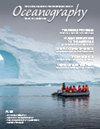Exploring New Technologies for Plankton Observations and Monitoring of Ocean Health
IF 2.8
4区 地球科学
Q1 OCEANOGRAPHY
引用次数: 1
Abstract
oceans where they dominate life in terms of abundance and biomass (Bar-On and Milo, 2019). They are essential players in the functioning of marine ecosystems. Among them, microscopic algae called phytoplankton use sunlight to generate biomass from carbon dioxide and water, forming the basis of planktonic food webs, contributing about half of global primary productivity through photosynthesis, and producing about half of the world’s oxygen (Field et al., 1998). Phytoplankton are grazed by slightly larger, yet often still minuscule, animals called zooplankton that in turn are eaten by large predators such as fish or whales. Fish and many seabed-dwelling organisms such as corals or starfish commonly start their lives as zooplankton larvae. But plankton also include protists (flagellates, broadly defined), bacteria, and viruses, far tinier organisms that may feast on zooplankton leftovers or dead cells, or may live as parasites within the bodies of larger plankton cells. DNA analyses have revealed that less than 10% of the estimated total plankton biodiversity is known and formally described today—and most of the unknown species are smaller than the width of a hair (de Vargas et al., 2015). Plankton diversity is not equally distributed across the ocean. At the global scale, plankton differ from pole to pole according to temperature gradients and the degree of seasonal changes in the environment (Righetti et al., 2019). At local scales, nutrient availability, seasonal environmental variation, and interactions among species or with anthropogenic stressors determine plankton community composition (Beaugrand, 2014). Because plankton have short lifespans (often days or weeks) and their internal dynamics are tightly linked to global and local environmental conditions, they react quickly to environmental changes. These changes have cascading effects through the food web and significantly impact, for example, commercial fish recruitment. With the ocean under increasing stress from human activities, measuring changes in plankton communities is critical for addressing ocean health and food security and for tracking changes in nutrient and carbon cycles (including the effectiveness or disruption of the biological carbon pump; Zhang et al., 2018). Plankton diversity can serve as an indicator for tracking anthropogenic environmental disturbances brought about by the maritime industry (e.g., Figure 1), eutrophication, industrial wastewater, invasive species, overfishing, TOPIC 2. ECOSYSTEMS AND THEIR DIVERSITY探索浮游生物观测和海洋健康监测新技术
在海洋中,它们在丰度和生物量方面主宰着生命(Bar-On和Milo,2019)。它们是海洋生态系统运作的重要参与者。其中,被称为浮游植物的微小藻类利用阳光从二氧化碳和水中产生生物量,形成浮游生物食物网的基础,通过光合作用贡献了全球约一半的初级生产力,并产生了世界约一半的氧气(Field et al.,1998)。浮游植物由体型稍大但通常仍然很小的浮游动物捕食,这些动物反过来又被鱼类或鲸鱼等大型捕食者吃掉。鱼类和许多海底生物,如珊瑚或海星,通常以浮游动物幼虫的身份开始生活。但浮游生物也包括原生生物(广义的鞭毛虫)、细菌和病毒,这些更小的生物可能以浮游动物的残渣或死细胞为食,也可能在较大的浮游生物细胞体内作为寄生虫生活。DNA分析显示,目前已知和正式描述的浮游生物生物多样性估计总数不到10%,而且大多数未知物种都小于一根头发的宽度(de Vargas等人,2015)。浮游生物的多样性在海洋中的分布并不均匀。在全球范围内,浮游生物因温度梯度和环境的季节变化程度而异(Righetti等人,2019)。在当地范围内,营养物质的可用性、季节性环境变化以及物种之间或与人为压力源的相互作用决定了浮游生物群落的组成(Beaugrand,2014)。由于浮游生物的寿命较短(通常为几天或几周),其内部动力学与全球和当地环境条件密切相关,因此它们对环境变化反应迅速。这些变化通过食物网产生连锁效应,并对商业鱼类的招募产生重大影响。随着海洋受到人类活动越来越大的压力,测量浮游生物群落的变化对于解决海洋健康和粮食安全问题以及跟踪营养和碳循环的变化至关重要(包括生物碳泵的有效性或破坏性;Zhang等人,2018)。浮游生物多样性可以作为跟踪海洋工业(例如,图1)、富营养化、工业废水、入侵物种、过度捕捞、TOPIC 2带来的人为环境干扰的指标。生态系统及其多样性
本文章由计算机程序翻译,如有差异,请以英文原文为准。
求助全文
约1分钟内获得全文
求助全文
来源期刊

Oceanography
地学-海洋学
CiteScore
6.10
自引率
3.60%
发文量
39
审稿时长
6-12 weeks
期刊介绍:
First published in July 1988, Oceanography is the official magazine of The Oceanography Society. It contains peer-reviewed articles that chronicle all aspects of ocean science and its applications. In addition, Oceanography solicits and publishes news and information, meeting reports, hands-on laboratory exercises, career profiles, book reviews, and shorter, editor-reviewed articles that address public policy and education and how they are affected by science and technology. We encourage submission of short papers to the Breaking Waves section that describe novel approaches to multidisciplinary problems in ocean science.
 求助内容:
求助内容: 应助结果提醒方式:
应助结果提醒方式:


